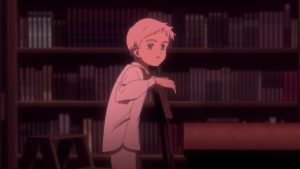 Nah, just kiddin’. Fact is there’s going to be all sorts of mystery every week with Yakusoku no Neverland, that’s just the sort of show it is. You’re no more likely to be spoiled by this episode than any other – which is not to say you shouldn’t be careful if such things bother you, because there will be lots of opportunities to see stuff you shouldn’t pretty much every episode. And that seems all the more true because the manga is progressing the story at a significantly faster rate than I remember the manga doing.
Nah, just kiddin’. Fact is there’s going to be all sorts of mystery every week with Yakusoku no Neverland, that’s just the sort of show it is. You’re no more likely to be spoiled by this episode than any other – which is not to say you shouldn’t be careful if such things bother you, because there will be lots of opportunities to see stuff you shouldn’t pretty much every episode. And that seems all the more true because the manga is progressing the story at a significantly faster rate than I remember the manga doing.
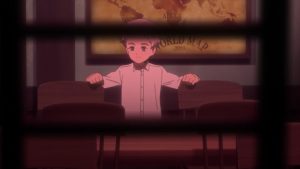 That part is rather interesting, given that even going in it seemed like a lock that Neverland was going to get a complete adaptation eventually. And not unexpectedly, the early signs are that what was already a major hit is going to blossom into a legit blockbuster, a major tipoff being that back-issues of the manga are almost all ranking on the weekly top 50 chart now. The Promised Neverland is big and about to be huge – so why burn through material quickly? It’s that ever-recurring “stopping point” question, surely – and while I didn’t go back and count out the chapters to see what kind of pace it would require to get there, I know with pretty much mortal certainty what that point is going to (and should) be.
That part is rather interesting, given that even going in it seemed like a lock that Neverland was going to get a complete adaptation eventually. And not unexpectedly, the early signs are that what was already a major hit is going to blossom into a legit blockbuster, a major tipoff being that back-issues of the manga are almost all ranking on the weekly top 50 chart now. The Promised Neverland is big and about to be huge – so why burn through material quickly? It’s that ever-recurring “stopping point” question, surely – and while I didn’t go back and count out the chapters to see what kind of pace it would require to get there, I know with pretty much mortal certainty what that point is going to (and should) be.
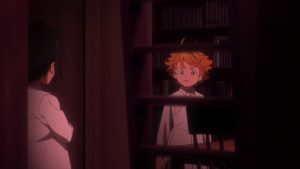 There’s a niche being filled by this series in the WSJ pantheon surely, one that’s been more or less vacant since Death Note ended. My take on that series was that it was brilliantly-executed pulp (and kinda trashy pulp at that) often mistaken for high art. With Neverland, ironically, I think you have less brilliance but more aspiration to high art. Either way both of them are insanely popular so I’m sure Shueisha doesn’t care a tiddle about what you call them. And if anything, the anime is playing up the pulpy part of the series more than the manga did (at least so far).
There’s a niche being filled by this series in the WSJ pantheon surely, one that’s been more or less vacant since Death Note ended. My take on that series was that it was brilliantly-executed pulp (and kinda trashy pulp at that) often mistaken for high art. With Neverland, ironically, I think you have less brilliance but more aspiration to high art. Either way both of them are insanely popular so I’m sure Shueisha doesn’t care a tiddle about what you call them. And if anything, the anime is playing up the pulpy part of the series more than the manga did (at least so far).
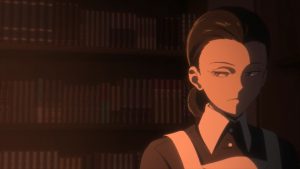 Sister Krone is a good example of that. I’m just going to have to set aside her character design – it is what it is – but she’s definitely more visibly (and audibly) bonkers in this version. One thing about anime Krone is that when she’s alone she seems not to have an unexpressed thought, which makes her a handy information portal for the audience. She lets us know that Isabella is considered rather a titan (now there’s another series I could compare this to) among “moms” – and Isabella in turn makes it clear that she expects Krone to support her in her efforts to contain the situation and no more.
Sister Krone is a good example of that. I’m just going to have to set aside her character design – it is what it is – but she’s definitely more visibly (and audibly) bonkers in this version. One thing about anime Krone is that when she’s alone she seems not to have an unexpressed thought, which makes her a handy information portal for the audience. She lets us know that Isabella is considered rather a titan (now there’s another series I could compare this to) among “moms” – and Isabella in turn makes it clear that she expects Krone to support her in her efforts to contain the situation and no more.
 It’s rather interesting that Isabella comes right out and tells Krone what’s happened with the last shipment, and who she suspects. It’s already obvious that information is a weapon in this setting, including the act of letting the enemy know some of what you know to try and cause them to reveal the rest. Krone employs this tactic almost immediately, through the ever-present vehicle of onigokko (tag) which always seems to be at the center of events at Grace Field. The power trio are already using it as a means of training up the younger kids at survival skills, but Krone immediately interjects herself – and in the process makes it absolutely clear that she suspects the truth about which children have seen things they shouldn’t see.
It’s rather interesting that Isabella comes right out and tells Krone what’s happened with the last shipment, and who she suspects. It’s already obvious that information is a weapon in this setting, including the act of letting the enemy know some of what you know to try and cause them to reveal the rest. Krone employs this tactic almost immediately, through the ever-present vehicle of onigokko (tag) which always seems to be at the center of events at Grace Field. The power trio are already using it as a means of training up the younger kids at survival skills, but Krone immediately interjects herself – and in the process makes it absolutely clear that she suspects the truth about which children have seen things they shouldn’t see.
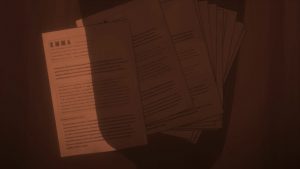 There’s certainly a power play going on here, and Krone’s presence complicates it considerably. She now knows something that could get Isabella in serious trouble – that she had an incident and the truth may have been revealed, and is choosing not to report it – and Krone is a rather ambitious sort. Of course the reason she knows is because Isabella told her in the first place. Isabella also intentionally tipped off the offending kids (even if she didn’t know for sure who they were) about the tracking devices, and Emma, Ray and Norman have followed the cookie crumbs to the truth about those, or at least part of it.
There’s certainly a power play going on here, and Krone’s presence complicates it considerably. She now knows something that could get Isabella in serious trouble – that she had an incident and the truth may have been revealed, and is choosing not to report it – and Krone is a rather ambitious sort. Of course the reason she knows is because Isabella told her in the first place. Isabella also intentionally tipped off the offending kids (even if she didn’t know for sure who they were) about the tracking devices, and Emma, Ray and Norman have followed the cookie crumbs to the truth about those, or at least part of it.
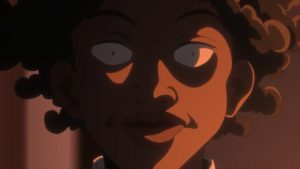 Yes, this is rather a splendid – if theatrical – cat-and-mouse. And the boys have figured out that Isabella’s lack of direct action since she let her suspicions be known means that she has a means of monitoring the situation without it – i.e., someone on the inside. Kanbe Mamoru does a rather sterling job of communicating the pervasive sense of paranoia at Grace Field House through his flashy depth-of-field tricks and over-stylized cinematography, which contributes to the overall arthouse feel this show sometimes takes on. Kanbe’s auteur mannerisms can be a bit much sometimes, but he seems to be a really good fit for the material here – Yakusoku no Neverland is all about mind games, and Kanbe loves to play those with the audience. So far, so good – and I don’t expect anything different in the weeks to come.
Yes, this is rather a splendid – if theatrical – cat-and-mouse. And the boys have figured out that Isabella’s lack of direct action since she let her suspicions be known means that she has a means of monitoring the situation without it – i.e., someone on the inside. Kanbe Mamoru does a rather sterling job of communicating the pervasive sense of paranoia at Grace Field House through his flashy depth-of-field tricks and over-stylized cinematography, which contributes to the overall arthouse feel this show sometimes takes on. Kanbe’s auteur mannerisms can be a bit much sometimes, but he seems to be a really good fit for the material here – Yakusoku no Neverland is all about mind games, and Kanbe loves to play those with the audience. So far, so good – and I don’t expect anything different in the weeks to come.


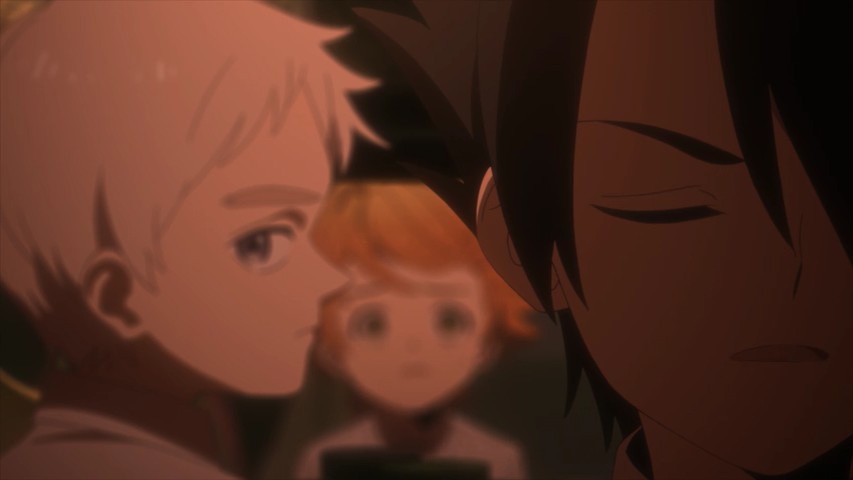
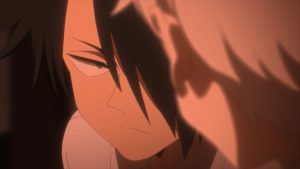
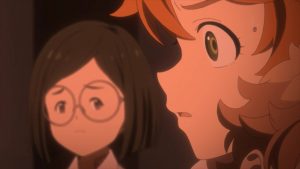
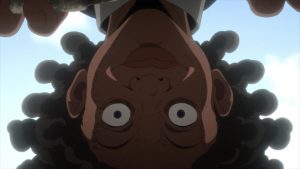

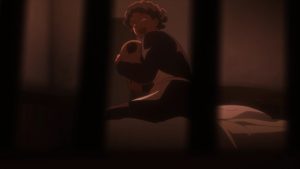
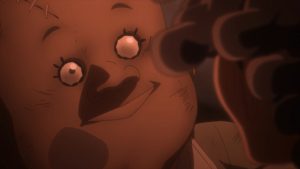
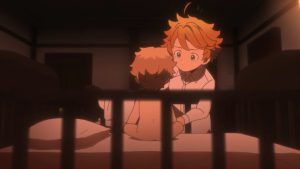
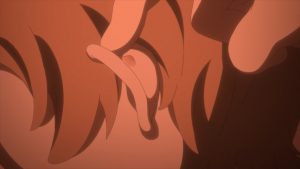
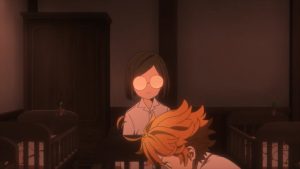
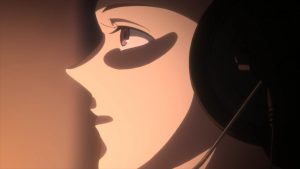
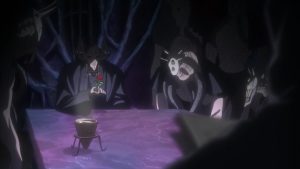
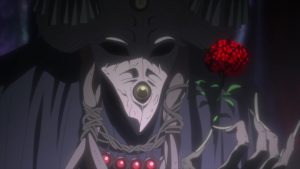
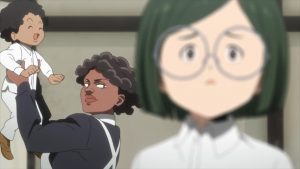
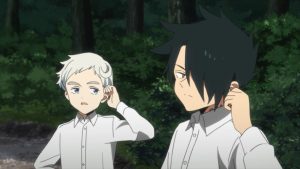
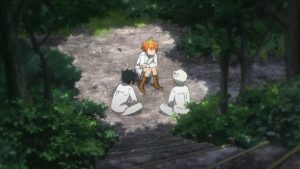
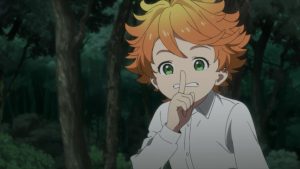
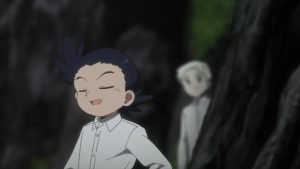
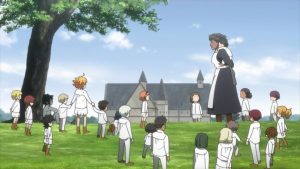
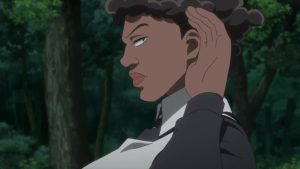
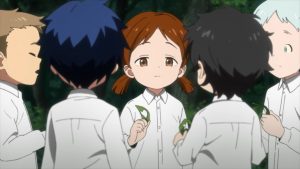
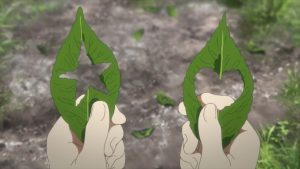
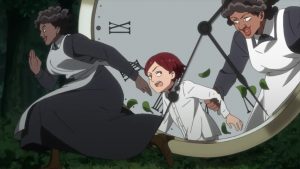
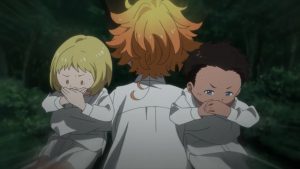
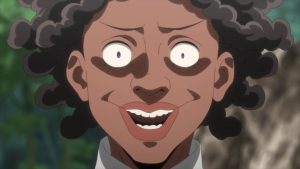
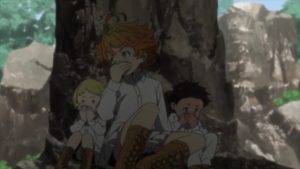
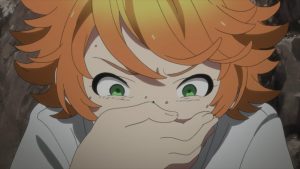
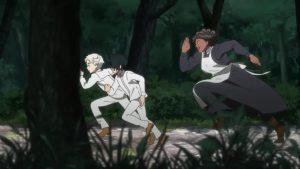
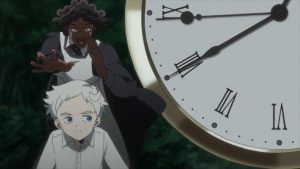

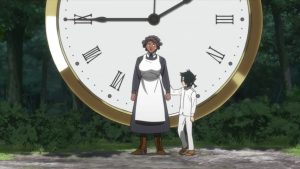
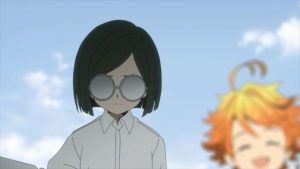
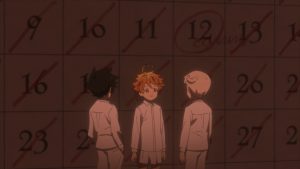
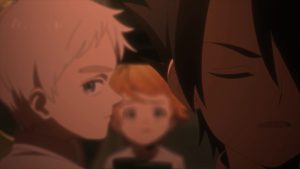
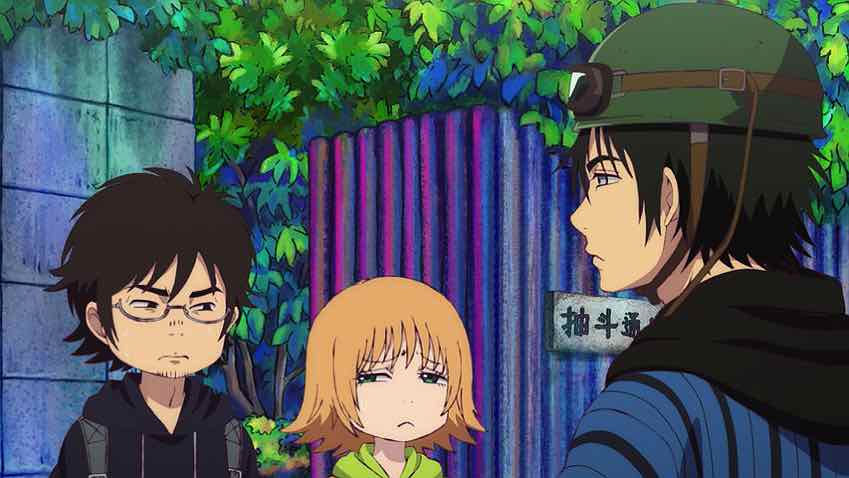
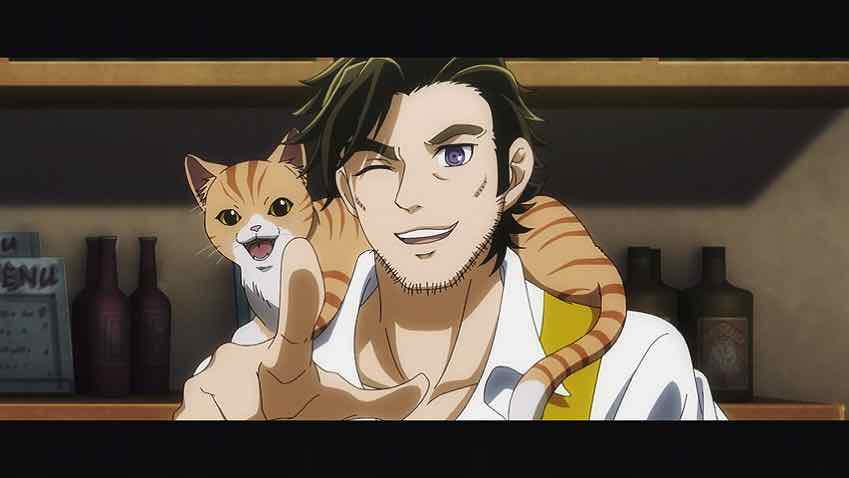
Simone
January 25, 2019 at 9:18 pmYour mention of Death Note being pulpy fun made me think of how I rewatched it recently with my brother and realised just how much humour it actually packs. It’s mostly deadpan humour, the kind of joke that is dropped with a completely straight face, but there’s a ton of it, which contributes to the sense that the show takes itself FAR less seriously than most would have it. That said, regardless of authorial intent, it manages to stir many passions, debates, and thoughts, so I’m not sure I would be so stingy with the definition of “art” – that would seem quite a snobbish approach to me, as if good genre fiction was automatically disqualified from that race due to its intrinsic lower standing. All that humans expressing their creativity make is art, some more enjoyable or cerebral than other, is all.
Concerning Sister Krone’s crazy monologue, I’ve heard from manga readers that it was an inner one in the source material, and this fixation with making everyone speak their thoughts out loud, no matter what it does to their character, seems like a worrying sign to me. I hope it doesn’t affect the show significantly going forward. For now, at least, it all looks good to me.
Guardian Enzo
January 25, 2019 at 9:56 pmAbout Death Note, I would say there’s a difference between “art” and “high art”. And I’m certainly not selling that series short – I just think some of the audiences takes on it were hilariously overwrought, and I suspect Ashirogi Muto thought so too. They were ‘avin a laugh with most of that series, playing tricks on their audience who were eating it up.
As to the Krone, yes, her thoughts were internal most of the time in the manga. But even internal they weren’t as histrionic as what anime Krone says out loud.
King Wombo Jr
January 25, 2019 at 10:09 pmI recall how The Good, The Bad and The Ugly was overlooked by many critics upon release because it is a spaghetti western, a genre which mostly pertained to lower-quality film making and storytelling.
Now it’s regarded as one of the greatest westerns of all time; film critic Roger Ebert would later add it to his great movies list (he had previously given it three out of four stars when first released), stating how he had previously underrated its effectiveness and storytelling because of it’s spaghetti western status.
~
My point is I’m in agreement that labeling Death Note as “pulp” shouldn’t mean it isn’t art as well, or that the labeling of something as pulp automatically disqualifies it as a piece of art.
King Wombo Jr
January 25, 2019 at 10:24 pmAh, Sister Krone. THIS was went I began falling in love with this arc, as soon as Krone stepped into the picture.
Not only is she wonderfully engaging and entertaining in all her over-the-top, wonderfully disturbing mannerisms, but she added a third party dynamic to this originally two-party game of chess; one that wasn’t on the children’s side, but wasn’t fully on Isabella’s side as well.
~
It’s funny how people were comparing Emma and Ray to Gon and Killua last episode’s review because it’s Krone who convinced me the writers of TPN were influenced/inspired by HXH with her sharing a lot of character traits with Hisoka:
Crazy, yet calculative. Over-the-top, disturbing expressions and giving off a creeper feeling when around the children. And in both mangas, Hisoka and Krone both use heart emojis at the end of their sentences when excited and/or happy.
There’s just too many similarities for her to have not at least been slightly influenced by the psycho magician.
Guardian Enzo
January 25, 2019 at 10:34 pmI confess, that comparison never, ever crossed my mind reading the manga. I’m tempted to go back and re-read to see if it does now, but I’ll wait and see if the anime prompts it.
A.Sade
January 26, 2019 at 12:02 amOh, I was totally sure there were HxH references in Krone’s character. From the moment I saw her in the manga, I was convinced that she had Hisoka’s craziness and uh, something of Canary’s design.
Guardian Enzo
January 26, 2019 at 12:26 amIn the sense that Canary and Krone are good examples of how to and how not to visually design a character respectively, I’d agree.
Simone
January 26, 2019 at 8:57 pmHonestly I don’t much understand this fixation with Krone’s design. I get why certain visual stereotypes are reminiscent of racist caricatures especially in the US, but if we bring up someone like Canary, the differences are so subtle that it’s hard for most people to even tell why one would be ok and the other wouldn’t. Ultimately, these are cartoon designs, that stylize or exaggerate real life traits without being realistic. The racist comics were insulting by combining a number of things – designs made to be not just caricatural, but purposefully ugly and dumb-looking, addition of details that implied negative traits (laziness, stupidity, sleaziness) and of course often even dialogue or actions that reinforced further that message.
I think US culture on this matter is too focused on the surface of things and too little on context and substance. And if that’s what Americans think like, fine, their choice, though I don’t think it’s an especially sensible one – but to judge what everyone else does on that meter too is just unfair. Intent matters most, while the meaning of symbols differs from culture to culture. There’s not much point in getting annoyed at a symbol that was never meant to convey what is read into it. It’s like thinking that a Buddhist temple is a Nazi haven because it has swastikas on it.
Guardian Enzo
January 26, 2019 at 9:12 pmWell personally, I find the designs for Krone and Canary to be starkly, dramatically different. But that’s just me.
FWIW, I’ve seen a lot of commentary from African-American anime fans who find Krone to be pretty offensive. To avoid spoilers I’m not going to get into the way she’s portrayed in terms of behavior – we haven’t seen enough of her in the anime yet for that to be safe ground, and they seem to be tweaking that aspect a lot anyway. But the actual, physical design of the character is to me pretty dodgy. I’ve seen worse, but where anime is concerned that’s a pretty low bar.
Simone
January 26, 2019 at 9:26 pmI’m not arguing that – and of course if there’s also stuff about her actions later that’s more understandable – but African-Americans are, well, Americans. That was my point. It’s a matter of culture before being one of race when it comes to how offensive certain symbols are considered. Then of course, if besides sharing the cultural understanding you *also* find yourself to be the nominal target of it, you’ll feel offended personally. But the culture is key. To make a more general example, no one would be especially offended by being called “son of a whore” without the shared cultural notion of prostitution being a low, degrading profession.